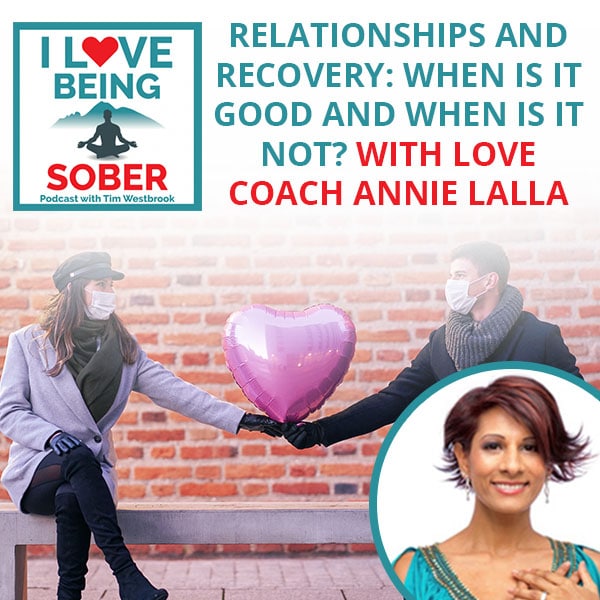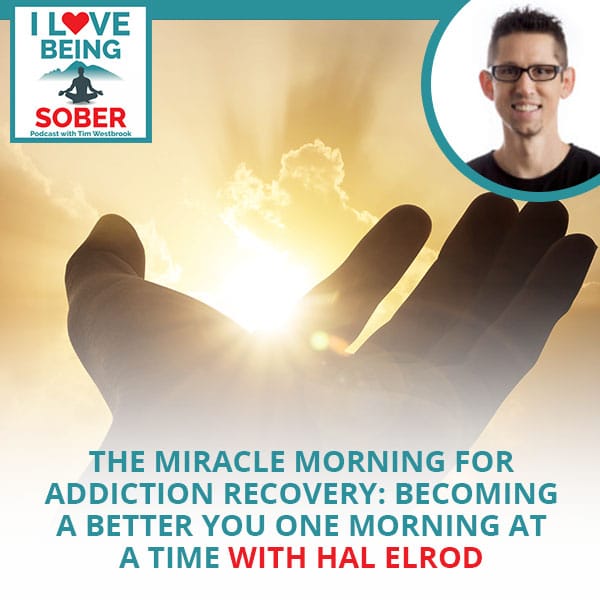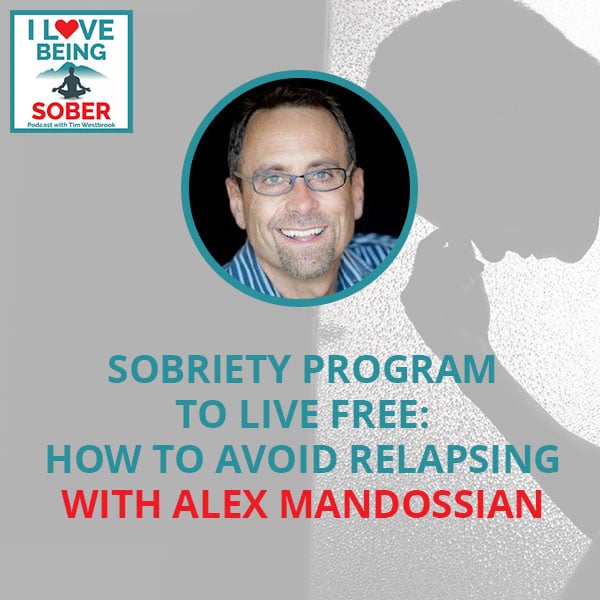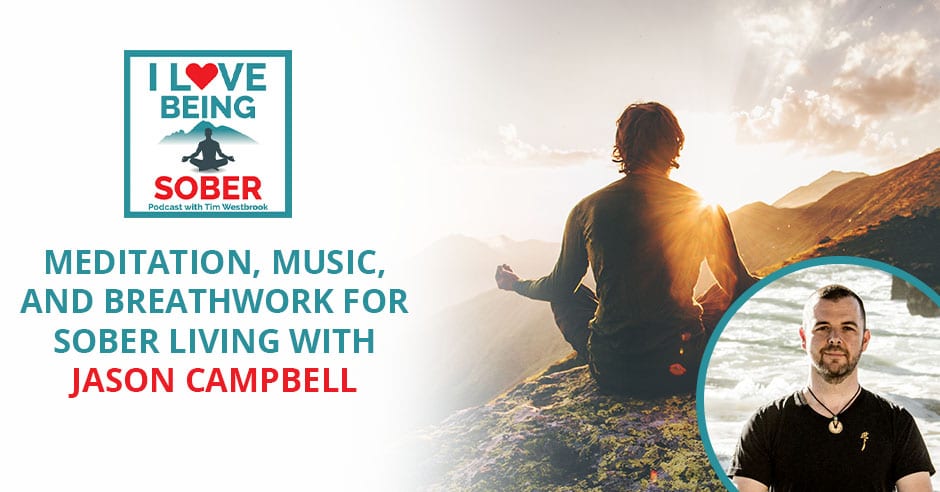
There is way more to recovery than just abstaining from drinking and doing drugs. People can get clean and sober by seeking other things to achieve fulfillment. On today’s show, Tim Westbrook chats with Jason Campbell, the Founder of Zen Wellness, an organization committed to health, healing, and longevity using the skillful means of time-tested Medical Qigong, Tai Chi, and Yoga. A 7th-degree black belt and Zen Wellness Master Teacher, Jason has been teaching the eastern healing and spiritual arts for over 25 years. Together, Tim and Jason talk about self-care and discipline, and explore the magic of meditation, music, and breathwork in assisting sober living, emphasizing how quieting your mind is such an important thing to do.
—
Watch the episode here:
Listen to the podcast here:
[fusebox_track_player url=”https://traffic.libsyn.com/secure/ilovebeingsober/ILBS_12_Jason_Campbell.mp3″ title=”Meditation, Music, And Breathwork For Sober Living With Jason Campbell” social_linkedin=”true” social_pinterest=”true” social_email=”true” ]Meditation, Music, And Breathwork For Sober Living With Jason Campbell
I am here with Jason Campbell of Zen Wellness. Being clean and sober is more than not just drinking and doing drugs. There’s way more to it. I’m going to tell a story. I remember about in 2019, I was with one of our clients, one of our residents, we were up at a treatment center and this was a resident that was disgruntled. It was myself and our Program Director, Anthony Tatum. We were up at The Meadows Outpatient Center and this resident was screaming. He was completely flying off the handle. He stopped and he said, “I’m concerned that Tim is not giving us a bigger reaction and that he’s not taking this seriously.”
My response was, “I’m here to listen and see what I can do to make this situation right.” What I realized after that meeting was that the guy was looking for a reaction. He was looking for a response. I was talking with a guy named Paul Sugar, who’s the Director of the Mindfulness Based Stress Reduction course. I was in the process of taking his class at that time. I talked to them about it and he said, “It’s because he wanted a reaction because he’s addicted to adrenaline.” Many people are addicted to chaos and adrenaline. This guy was early on in recovery. He went to inpatient treatment at The Meadows, and then he was a few days out.
To frame this correctly, this is a guy that was planning on staying at the Four Seasons for two months while he went to outpatient treatment but instead, he decided to go to sober living. Our sober living homes are nice. However, they’re not the Four Seasons. His expectations were much different than the services that we provided. The point being is that there’s way more to recovery than just not drinking and not doing drugs because the drinking and the doing drugs are the solution. If someone gets clean and sober, they seek other things to achieve fulfillment. You’ve got the drinking, drugs, excessively looking at Facebook, exercising, overeating, smoking cigarettes. There are many other things that people can do. When I first got sober, that was when I first dug into meditation and breathwork because quieting your mind is such an important thing to learn how to do.
I’m grateful to have Jason Campbell here as my guest. Jason is the Founder of the Zen Wellness Center. His unique perspective on health wellness and spiritual growth comes from his lifelong study of music and the ancient arts of Taoist health, medicine and enlightenment. He is a seventh-degree black belt and Cofounder of Zen Wellness. His meditation and Zen training began as a child through music. His whole adult life has been an effort combined with Eastern arts, wellness, meditation and music. He has released over twenty albums. He has been number one on the Billboard and Amazon, and created three musical styles, five-element meditation music, Zen piano and new opera. The music has opened meditation to many who have never meditated before or who have tried and been unsuccessful in their effort to simply sit and clear the mind. Jason, it’s good to have you here. Welcome.
It’s good to be here.
Where did it all start for you, Jason? I’ve known Jason for a while and he has led little workshops with our house managers intern. He has led meditation sessions with our sober living homes. He is a master. He’s 50 years old but doesn’t look 50 years old. He’s got secrets. Jason, tell me where it started for you. How did it start?
I’ll have to go back to when I was eight years old on the piano. My piano teacher said to me, “Never, ever listen to notes. Idiots listen to notes. Masters listen to space in between the notes.” When you hear a note, when your mind focuses on sound or notes, your mind is cluttered with thought. When you focus on silence or the space in-between notes, you stop the incessant stream of thinking, the inner voice in the head. When you drop the inner voice in the head, you can hear everything. Your mind becomes clear. We didn’t use the word meditation. I didn’t use that word until about a decade later when I was formally trained in ashram, sitting, kneeling, and doing breathwork, all the physical movement and the martial arts.
[bctt tweet=”There are many ways up the mountain. Don’t be attached to which way you get to it.” via=”no”]My entry point to it came from the sound. When I was formally trained later, I thought, “I’ve been doing this.” This is already what we’ve been doing. We came at it like a slightly different toolset, but it doesn’t matter how you get there. However you get up the mountain is however you get up the mountain. There are many ways up the mountain and don’t be attached to which way you get to the mountain. It points to some of your mindfulness or some of the training that you went through when you had the irate person who in his mind an expectation was not being lived up to. Whether real or perceived, he was going through that. How you were able to stay calm, have some space and respond as opposed to react, that comes when you have more space in your head.
Jason and I were supposed to start this show at 9:00. I logged into StreamYard which is the service I use and the broadcast somehow had got deleted. I wasn’t able to figure out how to go live. I went onto Facebook and I wasn’t able to figure it out. I called Jason and his alarm wasn’t set. He was unprepared. However, there’s no reason to react. Tell me, Jason, from your perspective, how did we handle that whole situation?
I don’t even notice because the technology didn’t go as planned. If you get thrown off-center every time technology does not go as planned, you’re going to have a tough life. Technology is a great example of it. If things don’t always go as planned, then you have a choice to how you react and how you respond. Is there a space between the action and the reaction? This is an example, “You couldn’t control it. You called me, “Text me when you get the link then we’ll do it and we’ll roll,” and here we are.
If getting stressed and upset helped, then I’d get stressed and upset immediately. I do it all the time. I teach seminars on how to get stressed and upset. Shorten your breath, look down, tighten your shoulders, think about what else could go wrong. Think about all the ways that you’ve been a victim and every way that somebody has wronged you. Now, stop your breathing and hold your breath, and make a mean face. We have seven steps or so, but most people are already masters at that. They don’t need my coaching.
When did you discover the magic of meditation and breathwork? Tell me the process. How old were you when you first realized this magic?
As a kid and training and music. It first came from the sound. It was my original meditation. When I was trained formally, it all made sense to me. I remember even at nineteen years old thinking, whether you’re playing piano, swinging a sword, conducting an orchestra, painting with a brush, it’s all the same. It’s about presence and being now. It’s about some type of art and expression. The real short version is I did all my music studies and I went to school. I was trained and had a career in music, but then in my mid-twenties, I decided to devote full-time to all my Zen training and my personal development. I opened studios and we started the business, raised a family, and did all those types of things.
I took about twenty years off from writing music professionally. When I came back to it a few years ago, it was clear. I’m going to blend all the ancient teachings, a lot of the Eastern teachings, and I’m going to translate it into music for a purpose of creating more stillness. Whether it’s music for some of the breathwork that we do, some of the mantra, a lot of it is meditation music or Zen piano, whatever the brand is that all points to that direction. If you listen to pop music, it’s some type of combination of, “I want you. I need you. I miss you. Let’s party and social commentary.” I’m not saying that is a good or bad thing. I love music and all types of music because of the way music makes you feel but it is usually that. That’s not my brand or the style that I’m doing. It’s all for some type of mental stillness, emotional stillness and personal development.

Meditation Practice: Things don’t always go as planned. You have a choice to how you react and respond.
Would you say music was first then?
That’s what I started at first. I took a couple of decades off before doing all the combination. If you even look at meditation, one of the things that we do is we help a lot of people not just meditate but a lot of people tried meditation and not succeeded with it or not felt like, “I got any benefit from it.” You started meditation, “I’m going to close my eyes. What’s happening now? What am I supposed to do? I’m looking around? What am I missing here?” We have people that come to us and they’re honest when they talk about their experience with meditation, “It was almost stressful because I’m sitting here being still and I’m not getting anything done. I have this list and I need to get things done,” or the stress of the addiction, media addiction, phone addiction or the need to picking up your phone and scrolling.
There’s a lot of addiction there and it makes the mind turbid. Little stillness is going to come through Instagram or looking at Facebook. It makes your head full of stuff and it creates more thought. When we look at meditation, there are three types of meditation and we call that sitting, standing and moving. Sitting meditation is what you normally think of as meditating when you’re still, but there’s a movement that you can do. There’s a bunch of standing postures that you can do. Usually, we start our members on some type of all three. Sometimes we have people that come to us that their sitting is hard for them, to sit and be still. We say, “Don’t worry about that. Let’s give you some moving meditation,” or it’s a combination of movement, breath, intention and that gets it started. After a while, it becomes much easier to sit and be still.
A lot of times people feel unsuccessful at meditating because nothing is happening. It’s like we want this spiritual awakening the first time we meditate or every single time we meditate, and that’s not the case. It’s a meditation practice. I can relate to this. If I’m meditating, I’m not getting anything done. I’ve got a gazillion things going on in my head and I’m like, “I don’t have time to meditate for five minutes because I’ve got a list that’s 300 things long.” How do you overcome that urge?
Let’s back up a few steps here. Think of the nature of the mind. We have two parts and there’s a teaching in the word human being. The human part changes every day. You and I are different than when we were eight years old from a human viewpoint. From a being viewpoint, which think of being is the observer, the eternal I am, the being doesn’t change. The eight-year-old observer is the same as it is now and the same as it will always be. When I say observer, think of it as that which watches your thoughts. One of the internal disciplines is the ability to watch your thoughts. The analogy I like to use is like a cat looking at a mouse hole. The cat stares and waits.
When you can activate the observer and watch the stream of consciousness, that creates a little bit of space between you and the thought. It’s been estimated that we have about 60,000 to 100,000 thoughts per day, and 99% of them are the same thoughts we had yesterday. It’s like a skipped record of recurring thoughts. The first step is to watch them and realize that most of the thoughts you have, you don’t need. It’s taking up headspace and room for new thoughts or something that’s going to be more creative. When you start the discipline of watching it, that’s when you can start to have a little break of no thought. The voice in the head goes, “Blah, blah, blah,” and that little space is almost like a crack.
Think of it as a crack that’s letting light in. There’s even a Japanese word for that experience. It’s called satori, which roughly translates into a glimpse of enlightenment. All you need is the crack because once you experience it, you can’t unring that bell. By having that, you have fewer thoughts, less mental and emotional turbidity. You have room for more creative thoughts or better thoughts. It even changes the brain chemistry. There have been more studies than you could possibly ever read or study that’s been done on meditation and brain chemistry on meditation. The short answer is it increases dopamine and serotonin, which are the happy chemical. It can decrease cortisol, which is the death hormone, excessive cortisol.
[bctt tweet=” Respond as opposed to react.” via=”no”]What’s the goal of meditation?
The first step is to create a little gap in the incessant stream of thinking. You have a moment of no thought. It’s a moment of nothing and you’re sitting with nothing. I had one teacher years ago that would always say to me, “There’s no such thing as good or bad Zen. There’s only Zen. There’s no such thing as a good or bad meditation. There’s only meditation.” Even if your brain is a turbid snowstorm and you can’t stop thinking, that’s okay. Even if you make your body still and connecting with your breath for a couple of minutes and begin that process, that’s okay because with practice and doing something over and over again, you do get better at it.
The other thing that we find, especially in these pandemic times, is starting members with breathwork is also good. Sometimes you can’t stop the mind if it’s too much. We’ve got to get you doing some deep pranayama, which means deliberate breath with inhaling and exhaling. We have different kinds of meditations that we do with that. The breath is everything. If you look at somebody that’s stressed, I’ll bet you the person that was upset, was yelling and screaming was not deep breathing. Shallow chest breath and they’re oxygen-deprived. It tends to happen when you become stressed.
The average person has between 60,000 to 100,000 thoughts per day. Would it be fair to say that one of the goals of meditation is to bring that number down?
Yes, absolutely.
I would be curious to know if that could be measured.
I haven’t found a way to measure it but I’m looking forward to it.
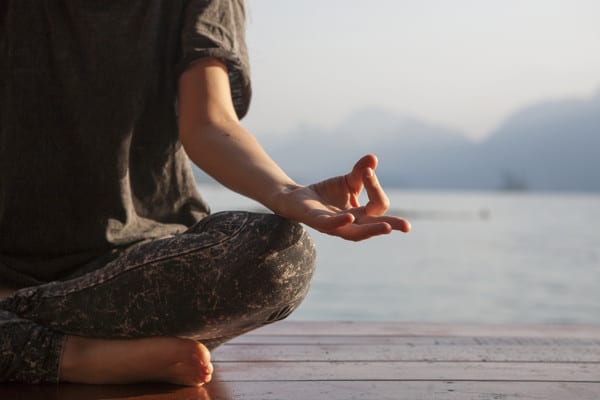
Meditation Practice: Moving meditation is a combination of movement, breath, and intention.
How many thoughts do you have per day? Ninety percent of those thoughts are the same thoughts that you had yesterday. How many of those are toxic thoughts?
It depends on the mind and I’ll bet a lot of them are toxic. There’s a joke about the inner dialogue is the asshole that lives in my head. Usually, the inner dialogue is not a nice person or it spends more time being negative than positive. The good news is that’s okay. You’re not going to change that. Don’t get angry at the monkey mind for being negative because the monkey mind is going to do what the monkey mind is going to do. If you try to say, “I need to think more positively.” That’s tough to do with the incessant stream of thought. What’s much easier to do is realize that it’s just your thoughts. You are not your thoughts.
The thoughts are just clouds going by. The second thing is you don’t have to judge them. You don’t have to take them seriously. If you have negative, nasty, ugly thoughts. It’s like ugly stormy clouds going by. You don’t have to act on them. When you create that little bit of space, you also become less judgmental towards yourself because they’re just your thoughts. It’s okay to have an ugly thought. Let’s give our readers a permission to have horrible, nasty, ugly thoughts. Don’t act on them or don’t take them seriously. Keep them as a thought and then you let them go like clouds passing by. You don’t even take them seriously. When you have negative, silly, stupid or ridiculous thoughts, you just smile and laugh.
That’s the monkey mind being crazy again. It’s crazy because it’s a monkey. There’s an old saying that says, “Chain the monkey to the tree.” It’s a playful way of saying, “Stop the incessant stream of thinking in the monkey mind.” However, I’m going to add to the old saying. You have to go into it realizing that the monkey is a master locksmith. However long you chain that monkey to the tree, it’s going to escape. No matter what you do, it’s coming out. It loves to trick you into even thinking it’s still chained because here’s what happens with members all the time. This is a process of development. You start the process and you do one of the disciplines to stop the mind from talking.
An easy one in the beginning as you say to yourself, “I wonder what thought I’m going to have next,” and then you wait for your next thought. The cat waiting for the mouse hole. Eventually, a thought comes out and you repeat. It’s one of many different exercises you can do to have less thoughts. Here’s what happens. You have a moment, “Blah, blah, blah,” and you have a moment with no blahs. The moment you realize that, “I’m not thinking anymore. I’m getting this. I’m cool. It’s rad. I’m not doing any more thoughts,” you blew it.
I say that playfully because it’s going to happen but that’s okay. The mind will trick you and the monkey mind will do that. When you catch yourself doing that, you have to smile and come back to, “I wonder what my next thought will be.” When you start to get this muscle of even having a couple of seconds of no thinking, it’s amazing what it does for your happiness, creativity, clarity, for dropping judgment on yourself and even judgment on others. It starts with that little crack of not thinking.
What do you say to the person that says, “I’ve tried to meditate, I can’t do it?”
[bctt tweet=”Internal discipline is the ability to just watch your thoughts. ” via=”no”]We say a few things and the first thing is, “When you say I can’t and then whatever it is, you’re usually right because the mind is not allowing you to do it.” The first thing I would say, “Let’s drop that.” We want to say, “You didn’t benefit from meditation in the past, fine, but then we want to take a different approach to it.” Usually, the person that has a hard time doing it will start with some type of breathwork like deep breathing. We have a whole series of breathwork exercises that we do. It’s like, “Don’t worry about trying to stop thinking. Let’s get you in your breath or even movement.” It’s because there’s a combination. This is the back of one of our books. This is an old concept and it translates to mean jing, qi, and shen.
What that means is we’re made up of matter, energy, and consciousness. The matter is everything you can see, touch and feel. The qi is the energy and that’s the breath. That’s also the emotion because you can’t hold emotion in your hand but it still exists as qi or bioelectrical energy, whatever we want to say, but it’s all things qi. Shen is spirit, consciousness, the awareness or the I am. An analogy I like to use with this is if we have H2O, solid, liquid and vapor would be the three. Likewise in meditation, we have sitting, standing and moving. When we do our movement, it’s the movement, breath and intention. I’ll give you a couple of answers to that. Sometimes we’ll start our members on, “Here’s the movement and don’t worry about trying to sit and be still.” If you’re willing to go through some of the phases of mastery and say, “I want to learn this and I’m going to do this,” then you’ve got to get over yourself and drop the I can’t and each day do a little bit.
For example, one of the breath exercises you do is you pump oxygen into your body, then you exhale everything and you hold the exhalation. You usually try and do 30 or 60 seconds. As you get stronger, you build up. We have many people who are lucky to do ten seconds holding the exhalation and that’s where they’re at. I say, “If you’re a ten, let’s see between now and next week, make it to eleven. In between next week, then make it to twelve.” It’s like, “I think I can do eleven.” You get to the ten and you do one more and you’re good. From 11 to 12, three months go by, they’re holding their breath for 60 seconds doing it. A lot of it is the mental block in the beginning or not thinking masterfully yet. Being a master in any subject is a skillset. Mastery is a skillset no matter what the skill. Let’s approach this from the mindset and the viewpoint of mastery.
It’s a tiny habits approach. It starts with 10 seconds, then 11, then 12 seconds. What is the recipe or what are your instructions to somebody who is newly in recovery or anybody for that matter who wants to learn how to meditate? What’s your advice?
I’ll give you a couple of things. We have a portal that I can give you. It’s EveryoneCanMeditate.org. It’s a free portal. There’s a bunch of stuff, music, and we have some exercises that we do in that. It depends on where your starting point is. Let’s do a little exercise with the readers, “I don’t have time to meditate. I can’t do it. This is too overwhelming. I know it’s something I should but I can’t do it.” Let’s do this. Close your eyes, inhale, exhale, open your eyes. You did your meditation for the day. Good job.
You can start with one breath and if that’s what it takes to start, do that. Maybe tomorrow you do two breaths, and then three breaths. If you’re having a hard time doing it, close your eyes and take deep breaths. That can get you started. There’s a lot more as we go along but I’d rather have you do that and do nothing because 1 breath leads to 2 breaths, leads to 5 breaths, leads to 10 breaths, and then you can get comfortable starting to sit and be still. The second part of that is the discipline of asking yourself, “I wonder what my next thought will be,” and waiting for the thought and see if you can have a split second of not having a thought.
When you start, you have to find the time that works for you. A lot of my music that I wrote for this were five-minute pieces to get people to meditate for five minutes. There’s a bell every four seconds. You breathe when you hear the bell and you exhale. You put on headphones or listen however you want to listen, then that’s a five-minute. If five minutes is too much, do one minute. If you don’t want to listen to music, put on a countdown timer, close your eyes and breathe for one minute but do get started because when you start this process, it is an amazing process. I have yet to meet anybody that says, “I wish I didn’t start that meditation habit.” I haven’t found anything or anyone that’s ever said that. This has completely changed my life, my body chemistry, and how I relate to myself and others. It’s the little bit of space between action, reaction, and the change of brain chemistry that’s amazing.
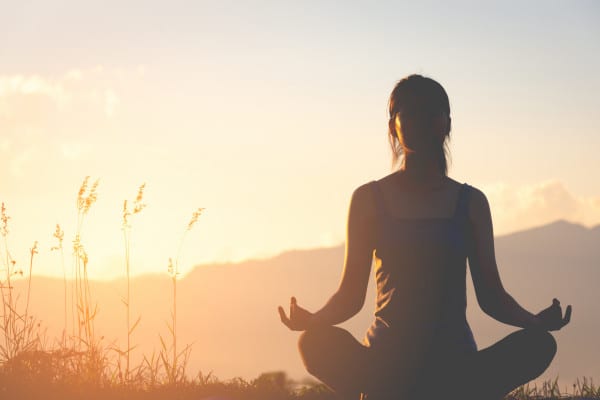
Meditation Practice: When you can activate the observer and watch the stream of consciousness, that creates a little bit of space between you and the thought.
I can relate. Meditation has been a game-changer for myself. I know many people that meditate. What about the time of day? Going back to the newcomer or going back to the person trying to learn how to meditate, when should they meditate? First thing in the morning, during the middle of the day, in the evening. Do you have any suggestions?
I have a few different answers to it. The first answer is whenever you can is good. Whatever works and the time to meditate is now. There’s the saying, “The best time to plant a tree is twenty years ago. The second-best time is now.” The best time to start a meditation discipline is twenty years ago. The second -best time is right now. The second thing is we do find that when you do it early morning, the first thing, you have better success with it, but it is good if you can pull it off. One is the psychology of having it done with. It’s like exercising or there’s something that you do in the day, when you can do it in the morning, you get it out of the way and your day is different.
You feel good about yourself. “I did my meditation. I did my breathwork, but I’ll take it any time throughout the day.” We have a lot of our members that will do little blocks of meditation through the day. They’ll take a loop or a little break, make your body still, or do one of the movements or breath exercises. You think of it as you’re pumping life in your body all throughout the day. It’s like filling up the gas tank throughout the day. The first answer is any time. The second answer is to do it in the morning. The psychology, you got it done with.
I like the morning because my mind goes 100 miles an hour and I’m sure there are lots of people out there that can relate to me. My first thing before I get out of bed, I do breathwork, then the eleven-step prayer, and then I meditate for ten minutes. It’s like, “I get my meditation out of the way. I’m good.” I do meditate at different points in the day beyond that. A lot of times, I have way too much going on and I’m not able to get my stop. The next thing you know, I’m ready to go to bed. That’s how the day works.
You’re wise for doing it first thing in the morning because it also sets the tone of the day. Do you notice a difference on a day that you do meditate and the day that you don’t? Do you notice a difference?
I give myself an hour in the morning and some people make fun of me because, for example, I went and did my workout at 8:45. I’m up at 4:00 AM and I can barely make it to my class by 5:00 AM because I get up, do breathwork, pray, and meditate. I do red light therapy and get on my power plate. That time for me is self-care, which is what I’ve learned in recovery. It’s such an important thing for me to do to get my day started off on the right foot, to be centered, to be grounded, to not be reactionary. I don’t want to be a victim. I’m responsible. It starts by getting the day started. I can remember hitting snooze on my alarm clock and ten minutes goes by and another ten minutes goes by. The next thing you know, I’m running out the door and I don’t have any time to myself. I’m completely sideways when I do that. That time to quiet my mind has been a game-changer for my life.
The best investment that you can make is the investment in yourself. The morning discipline is good because it sets the day and it sets the tone. You never regret the time that you invest in yourself in whatever the modality that you do. The way nature is set up is funny. God played this funny trick on us where we’re issued this body. You don’t own your body. You think you own it, but it’s not yours. We borrow it because at some point, we give it back. It’s weird because we don’t know when we give it back. There are two things we do know. We do know that you have to give it back and the second thing is you don’t know when. It also requires maintenance like all things, like a car. If you don’t maintain your car, you’re going to have car problems.
[bctt tweet=”There’s no such thing as good or bad Zen; there’s only Zen.” via=”no”]The thing about the car is if you completely neglect it, you can replace a car. Good luck with replacing a body. You have to do some type of work and development even to maintain vitality because after your early 30s or around there, if you don’t do something, you start to feel it in the energy. It’s the energetic inflation that happens around there. Is that a good or a bad thing? I wasn’t consulted on the way nature is set up.
You have to do that. If somebody thinks, “You’re selfish by doing that.” That’s a little naive to say that. It’s selfless because if you’re in service of others, you have to make sure that your body is strong and you’re in a good state. If you always just give or you exhale without inhaling, at some point you don’t have anything to exhale anymore. You can only give what you have in abundance of. Taking care of yourself and having a self-care discipline, whatever that looks like for you, is essential. It’s not selfish, it’s selfless.
For someone that wants to meditate, is meditation just sitting there? Are there forms of meditation?
We break it into three different forms, sitting, standing and moving meditation. The movement meditation starts to loosen your body up. It loosens your joints and it starts to circulate the energy throughout your body. We call it breathe movement and intention. Standing was a whole series of static postures that you do with breath. That’s how you get the qi to move. It’s like steam rising when you stop. When you sit, the mental and emotional turbidity starts to settle. That’s why we call that sitting, standing, and moving meditation. There are examples in the website I gave, in the portal, about how to pull that off and do it.
I find doing yoga is spiritual, meditational, and physical. I do my sitting meditation every day but then I have the other things that I do like when I ride, run, swim or hike. Any time where I can be by myself to myself, I would consider that meditation for me as well.
It’s a meditation if you make it meditation because you can do a lot of things with meditation. What I always advise, if you think breath, movement, intention when you’re doing things physically. Gym work is good where you pump your biceps. I go to the gym a couple of times a week, you build up your biceps but let’s remember you don’t die of that bicep, you die of a heart attack. Make sure you’re doing a discipline that affects the organs and the circulation of energy within the organs. Let’s go back to doing curls in the gym. If I could clone you and one of you goes and does your curls, does your stuff, looking around, looking at the television or looking at other people, but you still do the exact same movement, and then your clone adds two things.
First is breath. You inhale as you come down. You exhale as you exert force, inhale, exhale. Let’s say a bench press. You exhale as you push the weight out. If you add your breath and then the second thing, if you add intention. What does that mean? Put your awareness into whatever muscle you’re working. If it’s in your bicep, you close your eyes, you put your mind right in the bicep, you feel every part of it as you’re breathing in, you’re moving. I clone you, then one person does that, one of your clones doesn’t. After a couple of months, there’s a huge difference. You can spend the same amount of time, but you get a much bigger return on investment if you add those two things, the breath and intention.

Meditation Practice: It’s been estimated that we have about 60,000 to 100,000 thoughts per day, and 99% of them are the same thoughts we had yesterday.
If people want to learn more about you or Zen Wellness, tell them where to find you and Zen Wellness.
EveryoneCanMeditate.org. We have a whole system and a portal, you can go in, get a lot of direction and music. We explain how to use the music and there are links to music. If you want some other overview, ZenWellness.us is one of them. If you want some more of my music, JasonCampbellMusic.net. You can also find me if you look me up on all the streaming services. There are other people with my same name, so type in Jason Campbell Meditation Music and you’ll get a bunch of stuff. If you want to pursue this, I suggest you go to the EveryoneCanMeditate.org site, and then we have a bunch of info for you there.
Jason’s music is fantastic. If you want to learn how to meditate, breathe along with him. It’s like you’re breathing with him, so it’s set up well.
It all comes from stillness. I do live what we’re talking about. In the piano music, the way it’s even composed is from a place of nothing and a place of complete stillness. I have a whole process for it, but if you listen to any of the Zen pianos, see if you can focus not on the notes but listen to the space in between the notes. Even going through deep listening, if you say, “I don’t have the headspace to meditate,” put on one of the Zen piano songs and the concept is that through deep listening, the space in the music creates space in your thoughts. It’s another way that you can get there. There are many ways up the mountain.
Jason, I appreciate you being on the show. Anything else that you want to share with people out there about breathwork and music?
I appreciate being on here and thank you for inviting me. Your place is amazing. When I went there before and we did some meditation, what you’re doing for sober living is cutting edge. It’s fantastic. I’m impressed with everything. The environment that you set up is amazing. In terms of starting, start small. Set yourself up to win even if it’s one breath. Close your eyes and do one breath a day. You can do that, do it right now and then you win. Tomorrow is two because when you feel like you fail at something, you don’t want to keep doing it. Set up the game so that you’re going to win and make it super simple and super easy. That’s how you build a long-term muscle, not just in meditation but anything.
People change best by feeling good, not by feeling bad. Start small. If your goal is one breath per day, then you’re going to accomplish 1, and then you make it 2, and then 3. That’s how to create a meditation practice or anything for that matter. Thanks, Jason. I hope you have a wonderful day.
Thank you, Tim.
Important Links:
- Mindfulness Based Stress Reduction
- EveryoneCanMeditate.org
- JasonCampbellMusic.net
- https://www.ZenWellness.us/
About Jason Campbell

